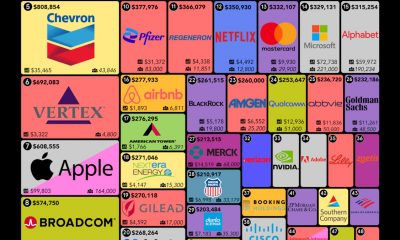Timelines
A History of the Oldest Flags in the World
The flag of Denmark has been in use since 1625, making it the oldest flag in the world that has been continuously used. Denmark’s national flag is called the Dannebrog. The white-on-red cross has been used as a symbol of Denmark allegedly since the 14th century, but it wasn’t until the 1600s that the current flag has been recognized as the country’s official flag.
Do you know the other flags that have been in continuous use the longest? The team at Wizard Pins examined flag designs from countries all around the world to visualize which ones have been continuously used by their respective countries the longest. Do you know which other countries have the oldest flags?
Click below to zoom
The countries with the oldest flags in continuous use include the following:
- Denmark (1625): Red background with a white Nordic cross
- Netherlands (1660): Horizontal bands of red, white, and blue
- Nepal (1743): The only irregularly-shaped flag consisting of two pennants with a red background (representing the color of the country’s national flower, the rhododendron) and a blue border (symbolizing the color of peace)
- United Kingdom (1801): The UK flag, also known as the Union Jack, is composed of the red cross of St. George, the saltire of St. Patrick, and the saltire of St. Andrew
- Chile (1817): The Chilean flag is composed of two equal horizontal bands of white and red with a blue square and five-pointed white star in the upper left corner
The flag of the United States, with all 50 stars and 13 states, was officially adopted in 1960.
Business Visualizations
Study Shows Three Decades of Self-Employment Trends
The U.S. economy and workforce landscape have seen many dramatic changes in the past three decades, not just in terms of trends, crises, and types of jobs workers pursue, but also in the way we work and structure careers. The team at Ooma created a new study displaying trending changes in self-employment. Their chart shows the percentage of the workforce that was self-employed each year. The numbers show that self-employment has always played a strong role in the American economy, with new Internet and digital industries pushing it to evolve. These changes present new opportunities and shake-ups to old work patterns.
Click below to zoom.
The Rise and Fall of Traditional Self-Employment
Ooma’s analysis is based on data from the U.S. Bureau of Labor Statistics. It shows that in 1994, self-employment represented 12.2% of the workforce. That’s 14.93 million Americans, a peak representing an economy where entrepreneurs, freelancers, contractors, and trades workers formed the backbone of the economy.
The next two decades saw a shift in self-employment, however. It declined to 9.8% by 2018, representing a shift to corporate employment in the era of social media and dot-com booms. The economy was recovering from a major recession that affected self-employed workers. Workers needed stability and benefits, and they turned away from gig work during the recession, with numbers plummeting to 59% in 2023.
The Impact of the Internet
Smartphone technology was developed in the late 1990s and perfected throughout the 2000s until it became a force that transformed the way we work. New apps like Uber, Instacart, and DoorDash ushered in a huge demand for gig work in the form of delivery drivers and people who could transform their own car into a taxi service. These platforms offered many work opportunities on top of a flexible schedule. People using these apps to get jobs could work whenever they wished.
Social media offered other exciting self-employment opportunities as we watched the rise of influencers and content creators who could market all kinds of digital goods and other services. A digital ecosystem made it more possible for personal brands to affordably market themselves to a wider audience.
The Pandemic as a Catalyst
The COVID-19 pandemic prompted huge changes in the way we work. Businesses closed down, layoffs surged, and many people looked for the quickest way to get flexible new employment. Self-employment options were the most accessible for many people. The self-employment workforce rose again to 4.2% in 2020. Many began to feel that starting their own business was more reliable than trusting a corporation. Marginalized people were especially drawn to self-employment, particularly women with families, and Black and Hispanic women. The flexible scheduling and greater power over work decisions was a more equitable fit for these women.
The team’s data proves that self-employment is so much more than just an alternative career choice. It can be an equalizer and drive American innovation. Self-employment can be a huge boost to local communities and continues to serve a vital role in our economy.
Charts
Timeline Displays Average U.S. Internet Speeds Over Time
In 1993, when the Internet became publicly available, the average speed was 14.4 Kb/s, and today, the average speed is 214 Mb/s. These are huge leaps in speed that can be difficult to understand. The team at Ooma shows the progression of this leap with a timeline of Internet speeds year by year. Tracking these Internet speeds can help us understand the technological developments that made this possible and show how the Internet has proliferated in daily life.
Click below to zoom.
At the top of the timeline, we see Internet speeds throughout the ‘90s at their slowest. Internet users had dial-up modems using phone lines to connect to the web. This was the slowest version of Internet technology we have seen on the timeline. The team provides context for the speed, explaining it would take almost four seconds to download an image of a meme, 11 minutes and 41 seconds to download an MP3 file of a song, and almost 34 hours to download the film, “The Dark Knight.” The peak speed reached in the dial-up era was 44.3 Kb/s. The graph shows significant jumps in speed in 1999, 2005, 2014, and 2022. These jumps occurred mainly due to technological advances, such as the creation of broadband and satellite Internet, as well as the expansion of access to higher speeds.
Context for today’s speeds compared to the past shows that it takes less than a second to download a meme, half a second to download an MP3, and only 8 seconds to download a long movie like “The Dark Knight.” Even though there have been vast improvements, the United States doesn’t have the fastest Internet speeds in the world. Singapore and the United Arab Emirates have higher speeds. The team tells us this is because of America’s vast landmass. It has been a challenge to provide high-speed Internet to rural areas, but there have been big improvements. Thanks to satellite Internet connections, people in more remote areas can have access to higher speeds.
Current projections show that by 2025, most of the world will have Internet access, even in remote areas with less infrastructure. The best equipment will be able to download a terabyte of data in just seconds through the use of fiber-optic cables, which are much faster than coaxial cables.
While there’s been great progress in providing high-speed Internet to rural areas, millions of Americans still don’t have access to high-speed Internet. The challenge is how to connect these locations to broadband. There are countless ways we have seen the Internet improve quality of life for people, from bringing them the ability to use telehealth, to social connections, to remote work opportunities. Timelines like this one from Ooma highlight progress but also remind us of the work that still needs to be done to improve American infrastructure. When we’ve seen such huge leaps in speeds, it’s not fair for some people to lack access to reliable Internet because of where they live.
Business Visualizations
Chart Visualizes the Price of the Ford Mustang Every Year Since Debut
The Ford Mustang is a legendary American muscle car that symbolizes the culture of open-road freedom. The Ford Motor Company designed the vehicle to embody the European sports car, but with a price point that’s more attainable for middle-class Americans. The idea was a massive success. The first Mustang debuted in 1964, and the Mustang enjoys a legacy and loyal fans to this day. The team at Speedway Motors celebrates the Mustang with an illustrated graphic depicting each Mustang iteration, along with the price at release and the price adjusted for inflation.
Click below to zoom.
Through this detailed and illustrated chart, we can see the evolution of this vehicle. The first Mustang Hardtop was priced at $2,368, which is $24,3444 in today’s market, emphasizing its affordability in the world of muscle cars. While the Mustang was a gamble, it proved to be a phenomenon and sold over 100,000 cars in its first four months. The Mustangs’ popularity persisted throughout the ‘60s, and Ford focused on improved performance and power, which meant prices rose. This trend continued until the early ‘70s gas crisis when Ford had to adjust to new consumer demands for better fuel mileage. They designed the Mustang II with a smaller chassis and less muscle to adjust to the changes in the economy.
The Mustang’s popularity hit a dip in the early ‘80s, and the Camaro almost outsold it. Ford innovated and adjusted again with the release of the Fox Mustang, designed to be versatile as a day-to-day muscle car. As technology advanced into the ‘90s, Ford introduced popular new features like a V8 engine and SN-95 chassis, which we can see featured in the Mustang GT.
Today’s Mustang is loaded with the most innovative features, designed for performance and comfort. The current model is the Dark Horse Premium, which sells for $69,375. While it’s a flashy and popular car, it lacks some of the performance boosts of past models, yet the price is high.
The Mustangs’ prices have risen a lot over the decades, for several key reasons besides inflation. First, safety standards have increased with innovative technology making drivers safer. Some safety features are required, while others are sought-after bonuses that drivers are looking for. A key aspect of a muscle car is the power and performance. Modern technology advances the performance of the vehicle, but that engineering comes at a higher price point. Material costs have advanced as well, from labor to raw materials. Cars, in general, are now more expensive to build.
The team’s chart is a true testament to the power of visual data. Through the images and price points, we can see changes in the Mustang reflecting cultural and economic shifts, creating a fascinating timeline of an icon among automobiles. Do you have a favorite Mustang model? What do you think about the price changes over time?
-

 Business Visualizations1 year ago
Business Visualizations1 year agoEverything Owned by Apple
-

 Business Visualizations1 year ago
Business Visualizations1 year agoAmerica’s Most Valuable Companies Ranked by Profit per Employee
-

 Business Visualizations10 months ago
Business Visualizations10 months agoThe Biggest Fortune 500 Company in Every State
-

 Business Visualizations7 months ago
Business Visualizations7 months agoThe Biggest Employers by Industry
-

 Maps2 years ago
Maps2 years agoPenis Lengths Around the World
-

 Business Visualizations2 years ago
Business Visualizations2 years agoAll The Brands Owned By PepsiCo
-

 Business Visualizations2 years ago
Business Visualizations2 years agoNew Animated Map Shows Airbnb’s Fully Booked Cities Along the 2024 Eclipse Path of Totality
-

 Business Visualizations2 years ago
Business Visualizations2 years agoEverything the Luxury Giant LVMH Owns in One Chart
















